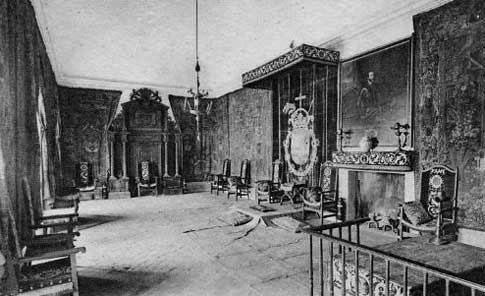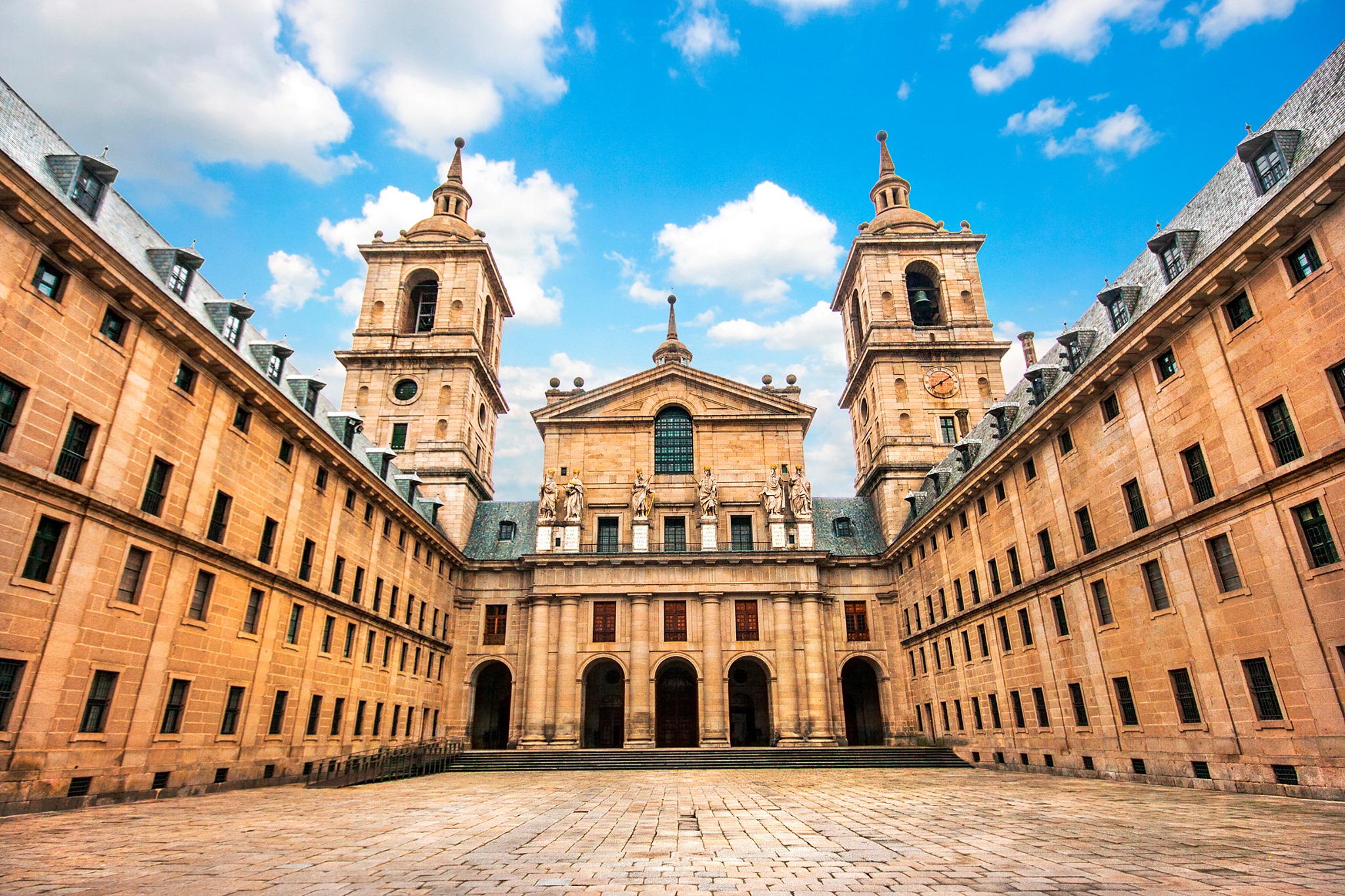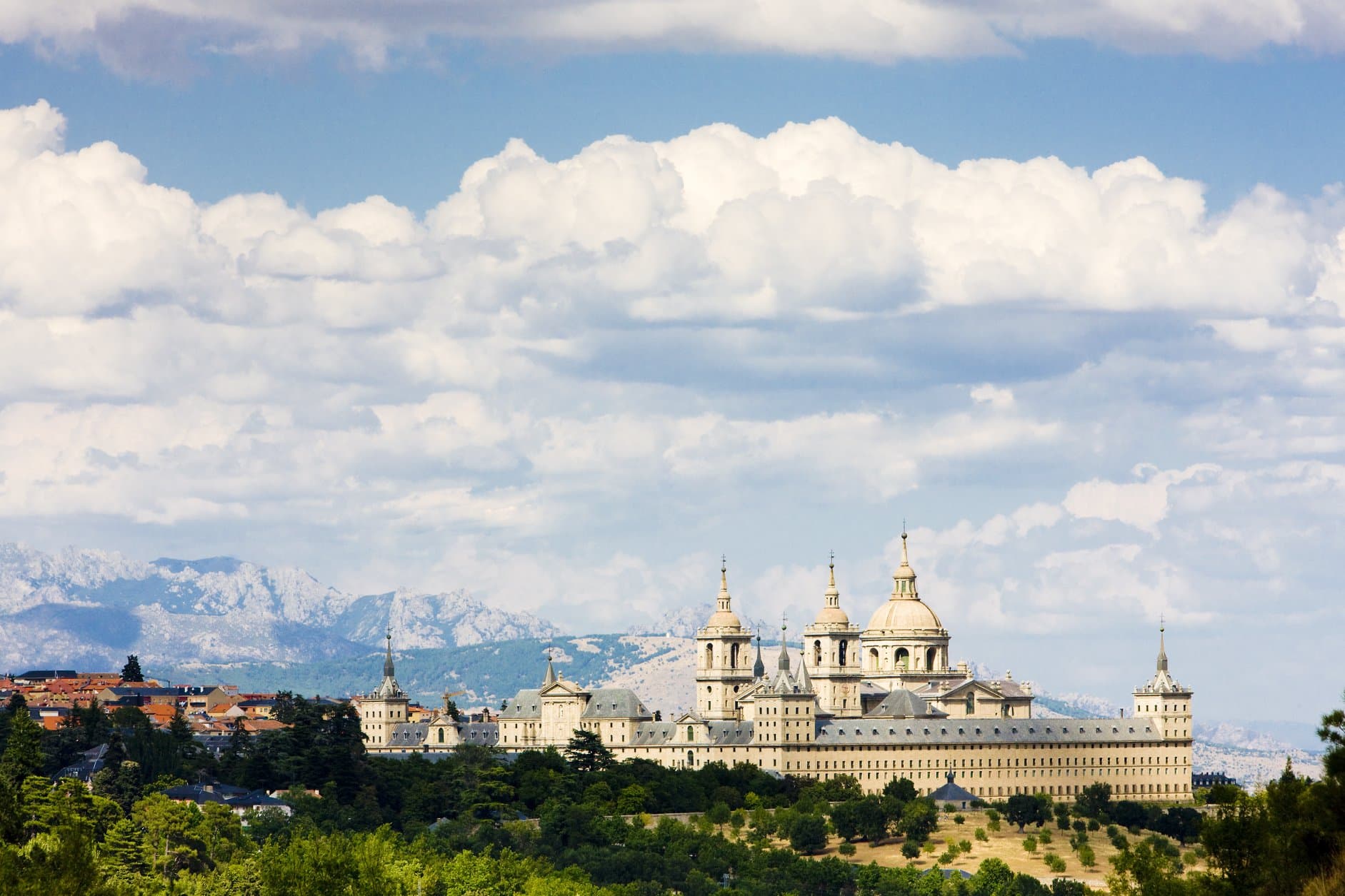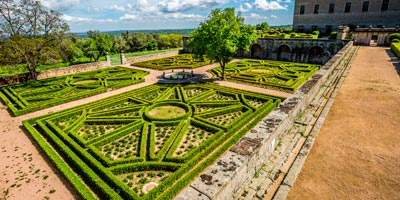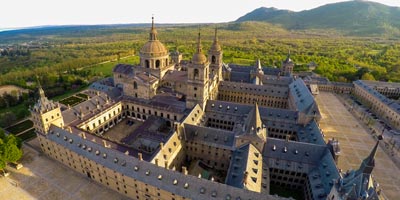Continuing the tour through all that can be seen in San Lorenzo de El Escorial, we arrive at the west facade. It is the main door that leads to the Patio de los Reyes. It is named after the sculptures of the kings of the tribe of Judah, sculpted by Juan Bautista Monegro. These are placed on pedestals on the facade that gives access to the basilica, with David and Solomon presiding. Likewise, in the centre of the left cornice a black cross marks the last stone that was completed in 1584.
The Basilica
On the other hand, the Basilica of the Monastery of San Lorenzo de El Escorial has a Greek cross plan. Its central dome, 92 metres high, stands out from the rest. Most of the vaults were painted by Luca Giordano. The exceptions are those above the choir and the high altar, the work of Luca Cambiasso. In addition, on both sides of the high altar there are two sets of bronze sculptures. They represent the kings Charles V and Philip II with their respective families, by Leo Leoni and his son Pompey.
In one of the chapels there is a remarkable Christ to be seen in San Lorenzo de El Escorial. It is made of white marble, by Benvenuto Cellini. He sculpted it completely naked, something unusual, although it is usually displayed covered with a white cloth. Important works are preserved in the sacristy, among them The Sacred Form by Claudio Coello.
An admirable library
The library also has one of the most valuable collections of books in the world, with more than 40,000 volumes. The collection of Arabic, Hebrew and Latin manuscripts is particularly noteworthy. It is said that the books on alchemy, magic and esotericism were placed upside down to hide the titles. However, other versions explain that the real reason was to air the leaves and show their golden edges.
Finally, the Jardín de los Frailes is well worth a visit. It can be accessed through the Arch of La Compaña. From here you can see the pond, the Huerta de los Frailes and the Dehesa de la Herrería. This is an essential visit to see in San Lorenzo de El Escorial.
Pavilions
The guided tour includes a visit to the two recreational pavilions designed by the architect Juan de Villanueva: the Casita del Infante and the Casita del Príncipe.
Firstly, the Casita del Infante (1771-1773) or Casita de Arriba was built for the Infante don Gabriel de Borbón, son of Charles III. It is a small villa with terraced gardens, in the Italian style. From here you can enjoy a beautiful view of the Monastery of San Lorenzo de El Escorial. King Juan Carlos I stayed here during his student period in the field of law.
Secondly, the Casita del Príncipe (1772) or Casita de Abajo owes its name to Charles IV when he was Prince of Asturias. Its architecture announces what will be Villanueva’s most emblematic work, the Prado National Museum. It was designed as a Natural Science Cabinet by order of Charles III. The neoclassical interior preserves the ceilings painted by Vicente Gómez, Mariano Salvador Maella and Francisco Bayeu.
In the gardens of the Casita del Príncipe there are still sequoias planted in the 18th century. Opposite the northern façade of the monastery is the First and Second Casa de Oficios. They were designed by Juan de Herrera to house different palatial rooms. Their works were continued by Francisco de Mora between 1587 and 1596.
Currently, the First Casa de Oficios houses the Casa de Cultura and Exhibition Hall. Also the Municipal Library “Manuel Andújar” and the Tourism Information Centre. In the Second Casa de Oficios, the old Laborantes Chapel, is located the Sanctuary of Nuestra Señora de Gracia. Every second Sunday of September the traditional pilgrimage in honour of the Virgin of Grace is celebrated.
“Padre Antonio Soler” Integrated Centre for Musical Studies is also located here. The Third Casa de Oficios was built at the end of the 18th century by Villanueva, commissioned by Charles III for the Count of Floridablanca. The architect continued the Herrerian model and with this building the perimeter of the Lonja was closed.
A Theatre-Coliseum
Then it was time to move on to the Royal Theatre Coliseum of Charles III, on Floridablanca Street. Charles III wanted to provide the Royal Sites with spaces exclusively for the performance of shows. That is why the Compañías de los Reales Sitios were created. They toured the different theaters. They also went, especially in autumn, to El Escorial, the period chosen by the monarch for his stays.
The French architect Jaime Marquet built this landmark to be seen in San Lorenzo de El Escorial in just one year, between 1770 and 1771. He followed a model that he also used in El Pardo and Aranjuez. It is the only theatre that preserves practically intact the typology of the 18th century. It is also one of the oldest preserved in Spain. The town has also had an Auditorium Theatre since 2006.
Next to the Royal Theatre Coliseum of Charles III is the Plaza de Jacinto Benavente. It is named after the playwright and Nobel Prize for Literature who, along with other authors, collaborated so much in the rehabilitation of the Coliseum. The square, presided over by Crispín, was the protagonist of Los Intereses creados. It also houses six magnificent centenary magnolias. It is one of the places most frequented by visitors to the town, who come to rest on its terraces.
Outstanding buildings
The Casa de la Compaña, now a Historic-Artistic Monument, was built by Francisco de Mora. This disciple of Juan de Herrera built it at the end of the 16th century as a warehouse for the monastery’s community of Hieronymite. At the end of the 19th century, the new community of Augustinian Fathers installed it in the building of the current Real Centro Universitario Escorial-María Cristina. Today it serves as the headquarters of the Summer Courses of the UCM in San Lorenzo de El Escorial.
Also by the architect Francisco de Mora and in the Herrerian style is the next monument to be seen in San Lorenzo de El Escorial. It is the Church of San Bernabé, built between 1594 and 1595. Declared an Asset of Cultural Interest, the same master stonemasons and craftsmen worked there as in the Monastery of El Escorial.
Next to the Royal Monastery is the Casa de los Infantes, designed at the end of the 18th century as the residence of the Infantes Francisco de Paula and Carlos María Isidro, sons of Charles IV. The building, restored by the architect Miguel de Oriol, currently houses the Infantes Campus, the headquarters of Euroforum. In an hotel from the 1940s is housed the second Campus of Philip II.
The La Herrería forest is a historic estate of oak and ash trees near the El Escorial Monastery. Silla de Felipe II is located there. It is a granite mass from where, according to tradition, the monarch observed the works of the monastery. Other theories consider it to be a Veton offering altar or a 19th century historicist work. The rock serves as a lookout point from which one can enjoy an impressive view of the monastery, Mount Abantos and the Seven Peaks mountains.
On the estate you will also find the Hermitage of Virgen de Gracia. Here the Virgin is carried from the Sanctuary of Nuestra Señora de Gracia in the middle of a large pilgrimage. It is celebrated on the second Sunday of September. It is possible to follow a footpath that starts behind the Casita del Príncipe and leads to the Silla de Felipe II.


